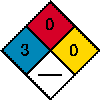| Lindane Index | Chemistry | Pentachlorophenol | Phosgene |
|
Names & Synonyms
Classification Code
Superlist Classification Code
File Locator
Internet Locators
|
Metabolite of lindane.Pentachlorophenol is an known and established carcinogen and is so listed by the State of California as a Proposition 65 cancer causing agent. DIOXIN IN PENTACHLOROPHENOL: A CASE STUDY OF CANCER DEATHS IN THE LUMBER INDUSTRY By Richard Alexander, Esq.http://consumerlawpage.com/article/lumber.shtml An Insecticide and herbicide that has also been used as a wood preservative. Pentachlorphenol is a widespread environmental pollutant. Both chronic and acute pentachlorophenol poisoning are medical concerns. The range of its biological actions is still being actively explored, but it is clearly a potent enzyme inhibitor and has been used as such as an experimental tool. Pentachlorophenol Pathway Map 1995 Human Health Effects: Evidence for Carcinogenicity: Evaluation: There is inadequate evidence in humans for the carcinogenicity of
pentachlorophenol. There is sufficient evidence in experimental animals for the
carcinogenicity of pentachlorophenol. Overall evaluation: Pentachlorophenol is
possibly carcinogenic to humans (2B). CLASSIFICATION: B2; probable human carcinogen BASIS FOR CLASSIFICATION: The
classification is based on inadequate human data and sufficient evidence of
carcinogenicity in animals: statistically significant increases in the
incidences of multiple biologically significant tumor types (hepatocellular
adenomas and carcinomas, adrenal medulla pheochromocytomas, and malignant
pheochromocytomas, and/or hemangiomas) in one or both sexes of B6C3F1 mice using
two different preparations of pentachlorophenol. In addition, a high incidence
of two uncommon tumors (adrenal medulla pheochromocytomas and hemangiomas/hemangiosarcomas)
was observed with both preparations. The classification is supported by
mutagenicity data, which provides some indication that pentachlorophenol has
clastogenic potential. HUMAN CARCINOGENICITY DATA: Inadequate. ANIMAL
CARCINOGENICITY DATA: Sufficient. The toxicological properties and carcinogenic potential of chlorophenols were
reviewed. Of 19 possible chlorinated phenol isomers available commercially, only
five were considered to be important: 2,4-dichlorophenol, 2,4,5-trichlorophenol,
2,4,6-trichlorophenol, 2,3,4,6-tetrachlorophenol, and pentachlorophenol.
Production, uses, and occurrence were described. Chlorophenols have been used
primarily as intermediates in the manufacture of chlorophenoxy herbicides.
Commercial formulations of chlorophenols contain polychlorinated dibenzodioxins
and polychlorinated dibenzofurans and other substances as impurities.
Pentachlorophenol has been used primarily as a fungicide. Alkali salts of
2,3,4,6-tetrachlorophenol have also been used as fungicides in wood
preservation. Occupational exposures to chlorophenols and their polychlorinated
dibenzodioxins and polychlorinated dibenzofuran impurities have been extensive.
Skin absorption is thought to be the major route of exposure. Incineration of
chlorophenol containing materials may result in polychlorinated dibenzodioxins
and polychlorinated dibenzofurans forming. Analytical methods for determining
chlorophenols were summarized. Biological data relevant to evaluating the
carcinogenic risk to humans were reviewed. Animal studies have provided
sufficient evidence of 2,4,6-trichlorophenol and
2,3,7,8-tetrachlorodibenzo-p-dioxin carcinogenicity and inconclusive evidence of
pentachlorophenol and 2,4,5-trichlorophenol carcinogenicity. In humans, two
studies showed no evidence of maternal reproductive toxicity stemming from
paternal exposure to 2,4,5-trichlorophenol, pentachlorophenol, and
2,3,7,8-tetrachlorodibenzo-p-dioxin. Studies of cytogenetic effects gave
conflicting results. Case control and epidemiologic studies of exposure to
chlorophenols and the incidence of the soft tissue sarcomas, malignant
lymphomas, the nasal and nasopharyngeal cancers have also yielded conflicting
results. It was concluded that there is limited evidence that occupational
exposure to chlorophenols poses a cancer risk to humans. EPA TSCA Section 8(b) CHEMICAL INVENTORY EPA TSCA Section 8(d) unpublished health/safety studies On EPA IRIS database EPA TSCA TEST SUBMISSION (TSCATS) DATA BASE, JUNE 1998 NIOSH Analytical Method, 1994: Pentachlorophenol, 5512; in blood, 8001; in urine, 8303 NTP Carcinogenesis Studies (feed); clear evidence; mouse NTP Carcinogenesis studies; on test (prechronic studies), OSHA ANALYTICAL METHOD #39 Tumorigen http://hazard.com/msds/tox/f/q90/q81.html Safety
Card --PENTACHLOROPHENOL 87-86-5 SM6300000 |
